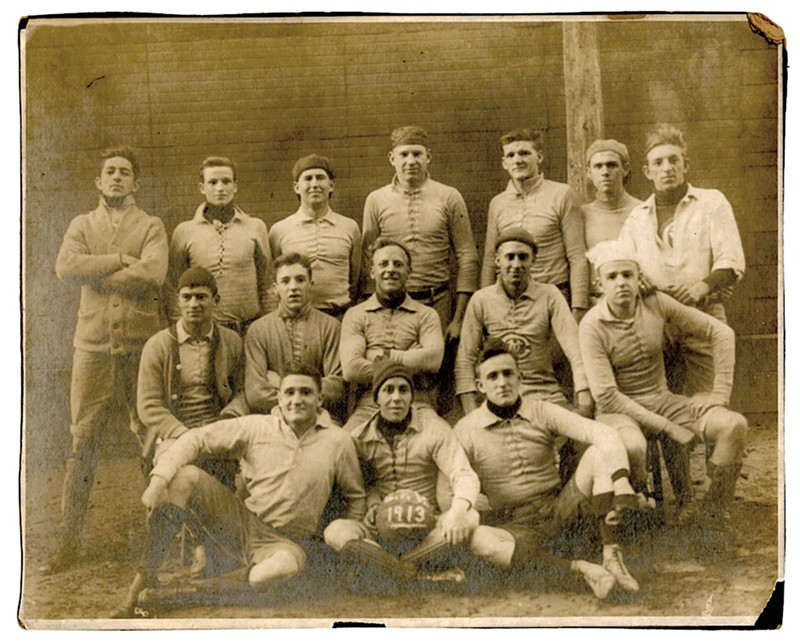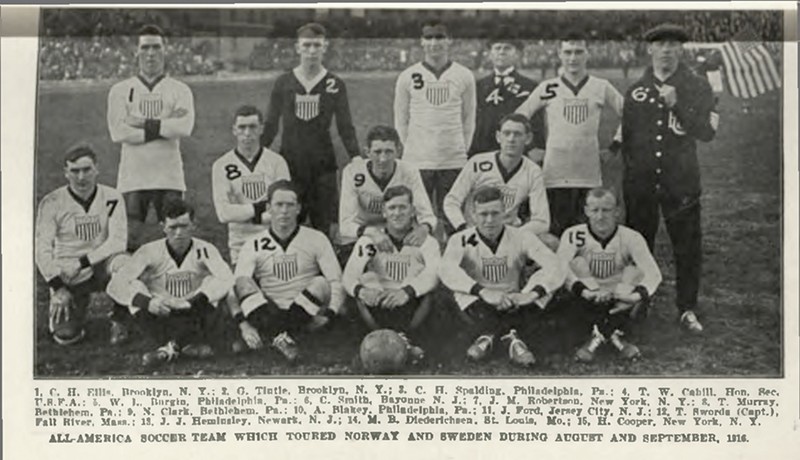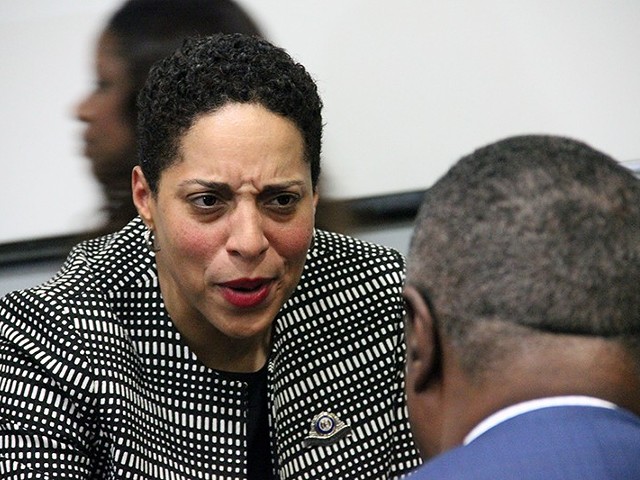St. Louis is not to American soccer what Cooperstown, New York, is to baseball or Springfield, Massachusetts, is to basketball. The sport had already gained a foothold in the northeastern U.S. decades before a St. Louisan named Thomas W. Cahill became the primary force for the sport's American emergence.
But Cahill did more than just about anyone in the U.S. to popularize the game — and St. Louis became one of its most significant, and longstanding, hotbeds. Without Cahill, we wouldn't have soccer as we know it today. And we certainly wouldn't call it soccer.
Cahill was the driving administrative force behind the sport in the U.S. for the first three decades of the 20th century. He founded the sport's first national governing body, the USFA, in 1913. He was the coach of the first American national soccer team and the first to bring an American team on an international tour. During the 1920s, he was the commissioner of the American Soccer League, the country's first national professional league.
Yet Cahill — and soccer's St. Louis roots — are hardly remembered today.
"Cahill was the giant in early U.S. soccer/football," says soccer historian Gregory Reck. Reck is the co-author of American Soccer: History, Culture, Class and a professor emeritus in anthropology at Appalachian State University. "The tragedy is that until recently, the legacy of Cahill and early U.S. soccer history was part of the amnesia of post-World War II U.S. soccer development. When critics of soccer claim that the sport is 'not American' and 'too recent' in the sports landscape, they are victims in one way or another of this historical amnesia, an insult to the decades of work by Cahill in service to the beautiful game."
"That generation is not as well known as it should be," soccer journalist and historian Tom Scholes says of Cahill and his fellow American soccer pioneers. Scholes is a British sports journalist and the author of Stateside Soccer: The Definitive History of Soccer in the United States. "Football, or soccer in America, does not exist in the guise that it does without Cahill. He should be held in immense esteem."
Now that St. Louis has a Major League Soccer team and a forthcoming exhibit about its soccer history at the Missouri History Museum, it's time to remember the man who made it all possible — for St. Louis, and for America.
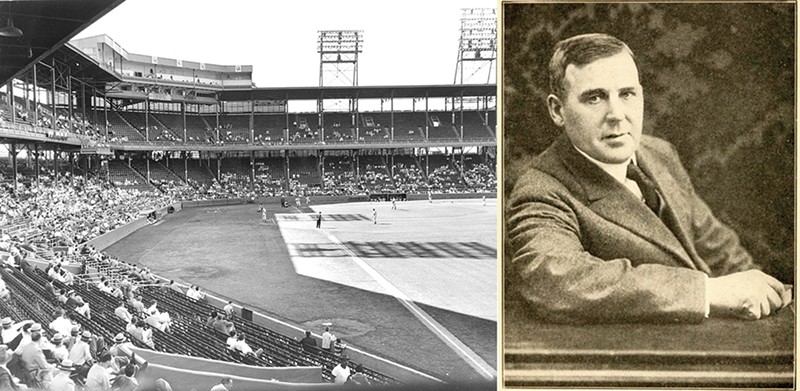
In the spring of 1917, a 4 million-strong American Expeditionary Force went to Europe to support the Allied cause in World War I. Less than a year before, in the summer of 1916, Thomas Cahill of St. Louis had brought a much smaller force to Europe: 11 American soccer players taking a tour of Sweden.
At the time, the U.S. and Sweden were both neutral in the Great War. While war enveloped most of the European continent, Cahill was corresponding with Sweden's national sports secretary. Cahill was the president of the United States Football Association, soccer's newly created governing body in America. On the side, he worked for Spalding, the country's leading sporting goods manufacturer, as its point man on soccer. Cahill sent his counterpart in Sweden a copy of the Spalding Guide to Soccer, an annual publication on the rules, strategy and history of the sport, which Cahill produced.
Impressed by the progress of the sport in America, the Swedish secretary encouraged Cahill to put together an American national team and bring them to Sweden for some exhibition games. The Swedes, in fact, footed the bill for the fledgling American organization.
The ever-diligent Cahill got to work. With the oversight of USFA, Cahill cobbled together a group he called the "All America Soccer Football Club." The team set sail from Hoboken, New Jersey, in July 1916, amid rising tensions between the U.S. and Germany in the north Atlantic.
While sailing across the ocean, Cahill put his team through rigorous workouts on deck. He taught them a fast, visceral style of play which would frustrate solid if unspectacular Scandinavian teams that were used to a more measured approach to the game.
This first U.S. national team surprised its hosts. The U.S. won or tied five of the six games on the tour. Crowds of as many as 20,000 — which on one occasion included King Gustav V — watched the Americans overwhelm their opposition. Cahill's no-holds-barred approach angered many Swedish fans, some of whom traded fists with American players after one of the games. But several newspapers in Sweden predicted that America would soon be the world's top soccer-playing country.
The 1916 American soccer tour of Scandinavia proved to be the first of three organized by Cahill. In 1919, he brought a team that represented the Bethlehem Steel Corporation, then one of America's top teams, to Scandinavia for a 14-game jaunt. The team won six, lost six and tied two. In 1920, he brought an all-star team that consisted largely of St. Louis-area players to Scandinavia. The St. Louis All-Star team won 12 of its 14 games and earned the personal congratulations of both Gustav V and King Christian of Denmark, both of whom saw the team play. It was surely heady stuff for a man who'd been raised in one of St. Louis' most notorious slums.
Cahill was born in either Yonkers, New York, or New York City, depending on the source, on Christmas Eve 1863 or Christmas Day 1864, to recent Irish immigrants. His family moved to St. Louis in 1871, part of a large wave of Irish Americans moving to the thriving industrial city. His family settled in the rough-and-tumble Kerry Patch neighborhood, an enclave of recent Irish immigrants located in present-day Carr Square. The neighborhood was known for its crowded tenements and the rival street gangs that competed for influence.
Cahill bore the signs of his hardscrabble youth throughout his life. He was regarded as a rough customer with a fiery temper, and even his adversaries remarked on his determination and sense of personal loyalty.
Cahill proved his athletic prowess at a young age, becoming one of the region's best competitive long-distance runners. His feats were profiled in The Sporting News, and in 1887 he won the western long-distance running championship, then a five-mile race held in Chicago.
Cahill attended Saint Louis University, where he was a track and baseball standout, before encountering his first soccer match in 1884. Impressed by soccer's speed, skill and athleticism, he soon became a player.
And not just a player. As Cahill wrote in the annual Spalding athletic guide to soccer in 1911, from that moment onward, he considered himself part of a "mission to spread the gospel of soccer and to show Americans what a spectacular, clean and athletic-building game soccer foot-ball really is when properly played."
The first recorded soccer matches in St. Louis took place in 1875 at the Grand Avenue Base Ball Park, the location on the corner of Grand Boulevard and Dodier Street that later became home to Sportsman's Park, where the St. Louis Browns and, later, the St. Louis Cardinals baseball teams played.
St. Louis was one of several American cities where a vibrant soccer subculture developed in the late 19th and early 20th centuries, built primarily around teams emerging from immigrant communities. The first leagues in St. Louis formed in 1885 among the city's large Irish American population. Italian and Spanish immigrants who came to St. Louis in the 1890s soon formed their own clubs and expanded the sport's reach across the city.
Christian Brothers College, too, played a significant role in the sport's growth locally, organizing teams from the elementary school through the collegiate level. This proved to be the starting point of a strong Parochial League sponsored by the Roman Catholic Archdiocese of St. Louis. In 1907, St. Louis even formed its first fully professional league. The grassroots growth of soccer in St. Louis contrasted greatly with the sport's other Midwestern hotbed, Chicago, where industrialist George Pullman invested heavily in the sport, driving interest.
This is the milieu Thomas Cahill played soccer in during the 1880s and 1890s. After his initial introduction to the sport at Saint Louis University, he starred on several local teams as a goaltender in his 20s and early 30s.
In his 2011 book Soccer Made in St. Louis, soccer historian Dave Lange describes a distinct St. Louis style of play that developed at the turn of the 20th century. The St. Louis game combined speed, physicality and a reliance on the "long ball" rather than intricate passes to move the ball up the field. This relentless, athletic style of play, which Cahill adopted in his own coaching, aggravated European opponents to no end.
But soccer wasn't Cahill's main source of income. By day, he worked on the railroad and moonlighted as a soccer writer for the St. Louis-based Sporting News. He eventually managed his own club, the St. Louis Shamrocks, who competed in the city's top league, the St. Louis Association Football League, known as the SLAFL. The Shamrocks won the league championship in 1899 and 1900. He went on to manage several other semi-professional teams in St. Louis before becoming SLAFL's secretary in 1903.
In 1908, Cahill traveled to England with his sights set on learning from the sport's originators. Cahill witnessed several soccer matches that drew sprawling, boisterous crowds of more than 40,000. He predicted that Americans would one day embrace the game in similar fashion. He also thought that Americans could one day compete with English players, if given the proper training.
"Football in England is just the same as the game of baseball to Americans. The players are required to train hard for the contests, are constantly in condition, play at least three games a week, and to this fact alone do I attribute their superiority to American players," Cahill told the St. Louis Globe-Democrat upon his return.
In January 1909, Cahill returned from another trip to the UK, where he met with representatives of several English soccer teams. A few English clubs conducted successful tours through the U.S. during the early 20th century. Cahill came to an agreement with one of the most well-known teams, a Sheffield-based touring football club called the Pilgrims F.C., who planned to play several dates in the U.S. that summer and fall.
Four years earlier, Pilgrims F.C. had played a pair of matches in St. Louis to crowds of several thousand after Cardinals baseball games. The four Pilgrims F.C. games against St. Louis teams in 1909 were another success, drawing thousands of fans to Sportsman's Park over a week.
Around this time, Cahill also began working on behalf of Spalding as a traveling salesman of soccer equipment, and in 1912, he took a permanent job with Spalding. He relocated from St. Louis to the company's headquarters in New York City, and he traveled the country, promoting both the sport and Spalding sporting gear.
In the late 19th and early 20th century, Spalding produced wildly popular guides for every major sport, which included the rules, instructions on how to play and brief histories. Between 1912 and 1924, Cahill edited an annual guide to American soccer as part of the Spalding Athletic Library.
He also tried organizing the sport on a national basis. He founded the American Amateur Football Association and tried to affiliate the group with the sport's international organization, Fédération Internationale de Football Association, better known as FIFA. Cahill attended the international organization's annual meeting in Stockholm in 1912, but was rebuffed in his efforts to turn his organization into the standard bearer of the sport in America. A rival group, the American Football Association, was also seeking affiliation. FIFA leaders encouraged the two sides to work out a compromise and return the next year.
On April 5, 1913, Cahill brought the factions together and built a genuinely national soccer organization. He put on a meeting in New York City with soccer enthusiasts from around the country at the Hotel Astor. The group hashed out the formation of the United States Football Association, the forerunner of the United States Soccer Federation, today the official governing body of the sport in the U.S. FIFA soon allowed this new organization to become a member and Cahill became the organization's first executive, serving as general secretary from 1913 until 1921 as well as briefer tenures between 1923 and 1931.
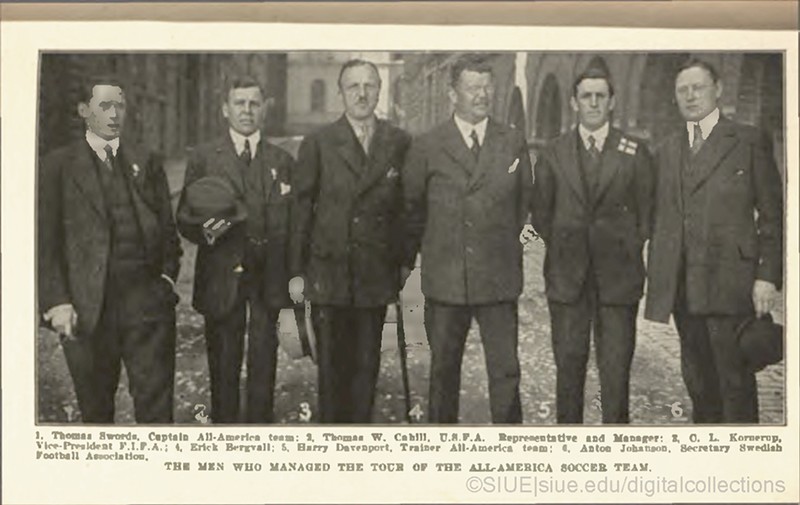
The Challenge Cup, a single-elimination national soccer tournament to determine the country's champion, became the centerpiece of the USFA calendar and its primary source of revenue via ticket sales. The Cup's direct connection to FIFA afforded it a unique prestige within American soccer circles.
Several of the country's best amateur teams of the early 20th century hailed from St. Louis, including Scullin Steel and the Ben Miller Hat Company, both of which were company-sponsored teams. After Scullin won the 1922 Challenge Cup, Cahill claimed that an 11-man team made up of only St. Louis players could beat any team in England.
While that boast was almost certainly a stretch, Cahill was right to laud his hometown's embarrassment of soccer riches. While most great American soccer teams of the early 20th century featured a number of foreign players, the St. Louis 11s consisted almost exclusively of American-born players.
Despite the inroads soccer was making, the settlement Cahill hashed out at the Hotel Astor was a temporary one, as factionalism proved endemic in the USFA. Independent clubs came into conflict with well-heeled company-backed ones. Regional power struggles and clashes of personalities further weakened the organization.
The politics weighed on Cahill, who was expected to police all the sport's factions. In 1920, when USFA proved financially incapable of sending a team to that year's summer Olympics in Antwerp, Cahill decided it was time to move on. He came to believe that the sport needed a regular professional circuit if it was going to build out from its niche to national support. He spearheaded the formation of the American Soccer League in 1921 and served as its secretary until 1926.
The ASL was in no way national. Its teams were exclusively in southern New England and the mid-Atlantic states. Nevertheless, it was the largest professional circuit yet in the U.S.
From the outset, the league was beset by the same old infighting and frequent conflict with USFA. Instability was a constant. More than 40 teams entered and left the league in its 12-year history.
Even so, Cahill made a pivotal directive during those years, convincing the leaders of the ASL to refer to their sport as "soccer" rather than "football," as it was known in most of the world.
According to author David Wangerin in Distant Corners: American Soccer's History of Missed Opportunities and Lost Causes, Cahill felt like the name "soccer" distinguished their activity from American football, which was already wildly popular across the country, particularly at the collegiate level. This pragmatic decision made clear business sense. It distinguished professional "soccer" in America from the amateur game with international aspirations that was promoted by the USFA.
Even so, "soccer" was not Cahill's coinage. The term first appeared in the 1870s as an abbreviation of the sport's full name, "association football." The nickname "soccer" referred to both the sport and its participants to differentiate them from "rugby football," which had become popular in Great Britain decades earlier. While in England, "football" became the preferred shorthand for "association football," and the term "soccer" gained prominence in other English-speaking countries such as the U.S., Canada and Australia.
Soccer could hardly compete with the top sporting attractions of the U.S. in the early 20th century: baseball, college football, boxing and horse racing. Yet in terms of popularity, the ASL was roughly as successful a live attraction during the 1920s as the National Football League. With the likes of Bethlehem Steel's Charles Schwab and New York (baseball) Giants owner Horace Stoneham behind them, the ASL also had a wealthier collection of backers than the new professional football league. Most NFL owners relied heavily on their teams as a source of family income. This was not the case in the ASL.
For the most part, Cahill kept the peace within the ASL during his reign, but not long after he left the ASL's leadership, a so-called "soccer war" emerged among rival factions in the USFA and the ASL. Essentially, ASL owners regarded the USFA as meddlesome and inflexible, unwilling to change rules to adapt to American sports conventions (such as allowing for substitutions and a playoff system) and stringent in its scheduling of the Challenge Cup, which hamstrung ASL's efforts to have a steady calendar of games. ASL owners also put the USFA in a bind internationally with its growing practice of recruiting European players to their league.
The dispute came to a head in 1928 when all but three ASL teams boycotted that year's Challenge Cup. Paid admission to Challenge Cup games had been the USFA's primary source of revenue. FIFA had the USFA's back and banned the ASL from international competition.
When the USFA tried to create its own rival league, the Eastern Soccer League, Cahill sided with the USFA and served as commissioner of the new league. But the divided house of American soccer could not stand, and neither league could withstand the economic calamities of the Great Depression. The Eastern Soccer League went out of business in the middle of its second season in 1929. The ASL closed shop in 1933.
A much smaller, less professional ASL replaced it later that season, but nothing about that organization approached the size, scale and popularity of the original ASL. For decades, professional soccer remained virtually invisible in American sports until a well-financed new league, the North American Soccer League, emerged in the late 1960s. Despite having high-profile backers and drawing many high-profile European players, the league never developed a strong or consistent television or live following. While the current major American men's professional league, MLS, has had its struggles over its slightly more than quarter-century in business, it has proven a much more stable entity than its predecessors.
Cahill's influence in the sport had clearly waned by the end of the 1920s. He was passed over as head coach for the U.S. soccer team that participated in the 1928 Summer Olympics and the U.S. team that played in the first World Cup in 1930.
At the same time, the popularity of soccer as a live attraction collapsed during the Great Depression, as the sport's primarily immigrant, working-class base of support faced economic peril. Player participation declined, too. Federal immigration restrictions put in place during the 1920s circumscribed the appeal of a sport that drew its ranks historically from new Americans who brought the game with them to this country.
This didn't discourage Cahill, now in his late 60s, from continuing to seek out new beachheads for the sport. He had some success during the 1930s promoting soccer in the southeastern U.S., even forming a semi-professional league in Tampa. Nevertheless, the "golden age" of the 1920s seemed further in the rearview mirror with each passing year.
Cahill's legend was still enough to earn him induction into the U.S. National Soccer Hall of Fame in 1950 as part of the organization's inaugural class. That same year, the U.S. team scored the greatest upset in its history, defeating England in World Cup play to the surprise of virtually everyone in the football world.
But Cahill didn't see victory. "I am sorry to say that the outlook for soccer football is, in my opinion, not bright. I mean with respect to it ever becoming a national pastime in this country. Years ago, we missed the boat," Cahill told St. Louis Post-Dispatch sports editor John E. Wray in November 1946, just a few years before his death.
To Cahill, soccer's failure was one of timing: At the professional level, the sport had failed to secure a season of its own. Baseball had the spring and summer. Football had the fall, and basketball and hockey by then had won over the winter.
And so when Cahill died in a New Jersey nursing home in 1951 at age 86, he believed that much of his life's work had been a waste.
He was, of course, wrong. That victory over England in 1950 was the first of many signs that, slowly but surely, his dreams were coming closer to reality. Soccer may not have become a national pastime, but it has evermore been at least a niche.
And in St. Louis, it has been a culture unto itself. The promotion of St. Louis CITY SC to MLS in 2023 and the construction of the soccer-specific CITYPARK stadium in Downtown West further cement what Thomas Cahill started to build more than a century ago. Soccer is here to stay.
Clayton Trutor holds a PhD in U.S. History from Boston College and teaches at Norwich University. He is the author of several books and is on Twitter @ClaytonTrutor.
Coming soon: Riverfront Times Daily newsletter. We’ll send you a handful of interesting St. Louis stories every morning. Subscribe now to not miss a thing.Follow us: Google News | NewsBreak | Reddit | Instagram | Facebook | Twitter

